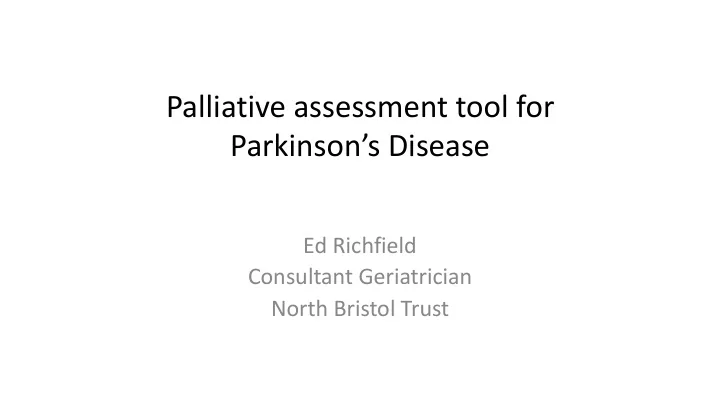

Palliative assessment tool for Parkinson’s Disease Ed Richfield Consultant Geriatrician North Bristol Trust
Respond to need throughout disease trajectory Diagnosi s Symptom s Information Tension Care tension Post Bereavement Diagnosis Death Advanced Care Planning, Ethical issues, Management of intractable symptoms
Identifying unmet need Prognosis: Necessary but not sufficient Death Active medical interventions Palliative care McMahon and Thomas - “Palliative phase” of Parkinson’s disease
Prognosis is necessary but not sufficient: The elephant in the room • Dementia – 60% at 12 years ( Butter et al. Neurology 2008; 70: 1017-22) – MCI twice as likely at diagnosis (Aarsland et al. Neurology 2009: 72; 1121-26) • Autonomy • Best interest >> ACP (Richfield et al. [abstract]. Mov Disord 2012; 27 Suppl 1 :551)
Delivering palliative in PD: The problem of numbers Negotiating the Chronic : Palliative interface NAT- Parkinson’s POS-PD ESES-PD
Models of care: symbiosis Chronic palliative interface
3 Stages of Assessment for unmet palliative care need • 1 – Rapid Identification • Awareness • Tool – Fast / Bedside / Limited patient / clinician burden • 2- Triage • Appropriate response / Sustainable referral • 3- Comprehensive palliative assessment • Less time dependent • Tool – comprehensive symptom assessment • Score for comparison over time
PACA Lee et al. Parkinsonism Relat. Disord 2007; 13: 284–289 • PACA - identify breadth of symptom load • Step 1: Self (patient) generated list of Sx • Step 2: Prompts from Sx check list • Step 3: Grade 1 (present) - 3 (dominating day)
PACA Advantages Disadvantages • Simplicity • Developed in Gen Hospital population • Well established • No PD specific clinimetric testing • Identify and grade Sx • Time consuming?
ESAS PD Miyasaki et al. Parkinsonism Relat Disord 2012: 18; S6-9 • Developed from ESAS with addition of 4 domains: – constipation, – difficulty swallowing, – stiffness – confusion • 14 domains each scored 0-10 • Max score 140
ESAS PD • ESAS PD domains: • Pain Tired • Nauseated Depressed • Anxious Drowsy • Appetite Wellbeing • SOB Other • Constipation Swallowing • Stiffness Confusion
ESAS PD Advantages Disadvantages • PD specific • Content validity? • Quantitative outcome • Clinimetric data for ESAS not ESAS-PD • Demonstrated change in response to interventions • Quick to use
POS-S PD Saleem et al . Palliat Med. 2013;27(8):722-31 • Adaptation of POS-S • 20 domains • GI / Neuro-Psych / Motor / Bladder • Rate 0 (no effect) – 4 (overwhelming) • Max score 80
POS-S PD Advantages Disadvantages • Comprehensive • No change in response to treatment data yet… • Quantitative outcome • Administration burden • Demonstrated change over time • Clinimetric data in PD?
Tackling the chronic / palliative interface. NAT: PD-c • Developed for cancer (Waller et al 2008) • Assess Patient / Carer / Family needs • Clinician administered • Minimal increase in consultation time (Waller et al 2012) • Adapted for other chronic conditions – Heart failure (Waller et al 2013) – ILD (ongoing)
Section 1 Red Flags Section 2 Patient Section 3 wellbein Ability of g carer to care for patient Section 4 Carer / family wellbeing Action s
Triage : NAT: Parkinson’s disease • HCP completed • Normal consultation • No increased clinic time
NAT: Parkinson’s Advantages Disadvantages • Wide ranging • No Quantitative outcome – Patient / carer / family • Less effective for response to • Clinician rated treatment – less patient burden • Clinimetric qualities modest • Rapid • Lack of peer review • Introduces triage of need
Issue specific tools in PD • Myriad available i.e: • Pain • Non-motor • Anxiety • Psycho-social • MDS website https://www.movementdisorders.org/MDS/Education/Rating-Scales.htm
The Model Service? ESAS-PD / POS- PD Symptom specific tools NAT:Parkinson’s disease
NAT: Parkinson’s disease Clinimetric properties Construct Comparator tool Correlation Reliability (Kendal’s tau b) (Weighted kappa) 0.39 Patient Physical PDQ (mobility) 0.51 Patient psych. PDQ (emotion) 0.55 0.33 0.27 Patient ADL MDSUPDRS - 2 0.62 0.21 Patient Spiritual PDQ (emotion) 0.42 Patient financial N/A 0.54 N/A 0.11 Patient health beliefs SCOPA PS 0.26 Carer Distress mCSI 0.63 0.62 Carer Physical MDSUPDRS - 2 0.48 0.48 0.48 Carer difficulty coping mCSI 0.46 Carer Inter-personal mCSI 0.29 0.32 0.28 Carer / family wellbeing mCSI 0.36 Carer / family grief mCSI 0.28 −0.01
Discussion of results • Construct validity – Majority Moderate or Good validity – Difficulty matching broad constructs – PD tools not designed for palliative constructs • Inter-rater reliability – Majority moderate of fair – Low Kappa at high percentage agreement – Range of assessors likely lowered reliability – Learning effect - ?better in real life
Recommend
More recommend